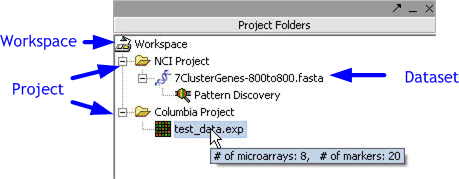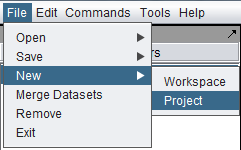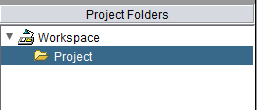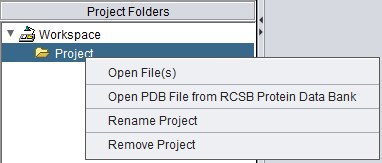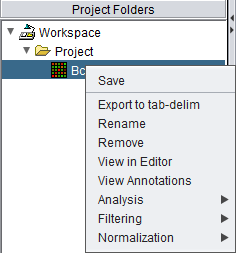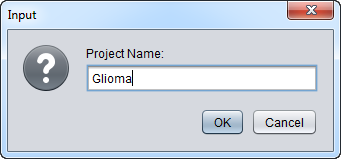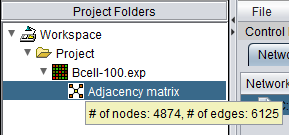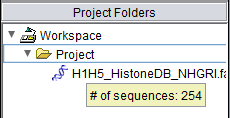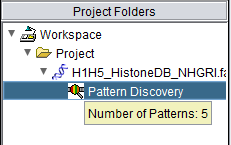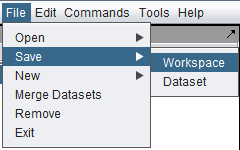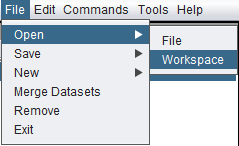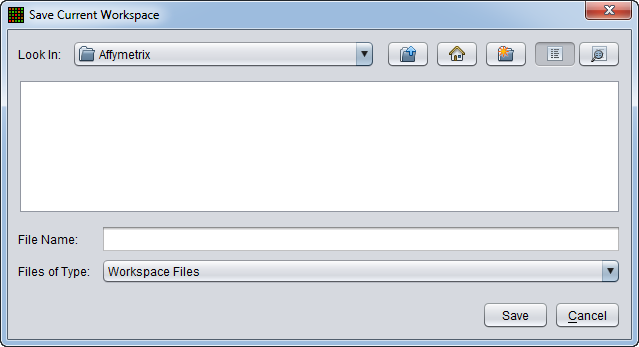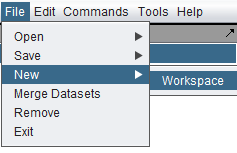Workspace
Contents
Project Folders Area
The Project Folders Area is located in the upper-left-hand corner of the application. This centralized workspace is used to manage projects, open data files and store intermediate analysis results during a geWorkbench session. When geWorkbench is launched, an empty Workspace folder is displayed.
Workspace
The workspace can contain one or more separate projects, and each project can contain opened data files and analysis results. An analogy might be that a workspace is like a drawer in a filing cabinet, and projects are individual folders in that drawer. Projects allow data to be grouped, for example by experiment. A project can contain many different types of data, for example microarray data, FASTA sequence files and graphical images.
The workspace as a whole, with all its projects and data nodes, can be saved and restored. However, only one workspace can be open at one time. Creating a new workspace or loading a saved workspace will overwrite the current workspace.
- To view the next level down in the hierarchy, click on the “+” icon to expand the branch.
- To collapse a branch, click on the “-” icon.
Projects
Project folders appear as child nodes immediately under the workspace node. Each project may contain several heterologous datasets. These datasets can include input (source) data and derived data (results) associated with an experiment as well as image files. Source data can be loaded from the user’s local storage or from remote servers. The grouping of datasets in project folders within geWorkbench does not change their physical storage locations.
The figure below is a Project Tree in the Project Area consisting of 2 projects: NCI Project and Columbia Project. All of the folders are open. The selected project is highlighted blue and bolded. The mouse-over displays information about the node to which it points.
Creating a new project
There are two ways to create a new project. First, select the Workspace node in the Project Folders component. Then, either
(1) In the top-level Menu, select File->New->Project.
or,
(2) In the Project Folders component, right-click on the Workspace and select "New Project".
Either way, the new Project is placed into the workspace:
Project Menu Options
Right-clicking on a Project node gives a menu with the following options
Open Files
- Loading data from local files is covered in the chapter Local Data Files
- Retrieving data from remote sources (caArray) is covered in Remote Data Sources
Open PDB File from RCSB Protein Data Bank
If Open PDB File from RCSB Protein Data Bank is chosen, a dialog box appears.
Type in the name of a PDB structure entry and it will be retrieved from the RCSB Protein Data Bank and loaded into geWorkbench.
Rename
A dialog box will appear in which to enter a new name for the project.
Remove
Selecting Remove will remove the project and all of its data nodes.
Project Data Node Menu Options
Right-clicking on a project data node will produce a popup menu with the following options:
Save
Save the currently selected data node. This is implemented for the following data types:
- Microarray gene expression - data is saved using the geWorkbench ".exp" format, regardless of the original format. This allows saving e.g. a merged dataset, and/or any array and marker sets that may have been created.
- FASTA - saved in FASTA format (.fasta).
- PDB - saved in PDB format (.pdb).
- Network - saved using the Adjacency Matrix "ADJ" format (.adj).
Export to tab-delim
This option will only appear for microarray gene expression datasets. It allows the microarray dataset to be exported in a spreadsheet format, as a tab-delimited text file. The first row contains array names and the first column contains the marker names.
This export format does not preserve array or marker sets that may have been defined in geWorkbench for the dataset. However, it can be used to save a copy of e.g. merged, filtered, and/or normalized data in a format easily used by other programs.
Rename
A dialog box will appear in which a new name can be entered.
Remove
The selected data node and any child data nodes it may have will be removed.
Project Data Node Hover-text Information
For microarray datasets, adjacency matrices (network nodes), sequence and pattern nodes, moving the mouse cursor over the data nodes will display additional details about a dataset.
Microarray datasets: hover text displays number of markers and arrays.
Adjacency Matrix: hover text displays number of nodes and edges in the network.
Sequence node:
Pattern node:
Workspaces
Saving a Workspace
Saving a workspace saves all of projects and data belonging to that workspace to a file on disk. The workspace can later be reloaded to resume work. However, workspaces in general may not be compatible across different versions of geWorkbench.
Opening a Saved Workspace
File->Open-Workspace.
Only one workspace at a time can be loaded in geWorkbench. Opening a saved workspace will destroy the existing workspace. For this reason, if you opt to open a workspace, you will be prompted as to whether to save the existing workspace first.
A dialog box will appear in which the location and file name to which to save the workspace can be chosen.
Creating a New Workspace
Only one workspace at a time can be loaded in geWorkbench. Creating a new workspace will destroy the existing workspace. For this reason, if you opt to create a new workspace, you will be prompted as to whether to save the existing workspace first.
A new workspace can only be created from the top level menu bar.
Select File->New->Workspace.

